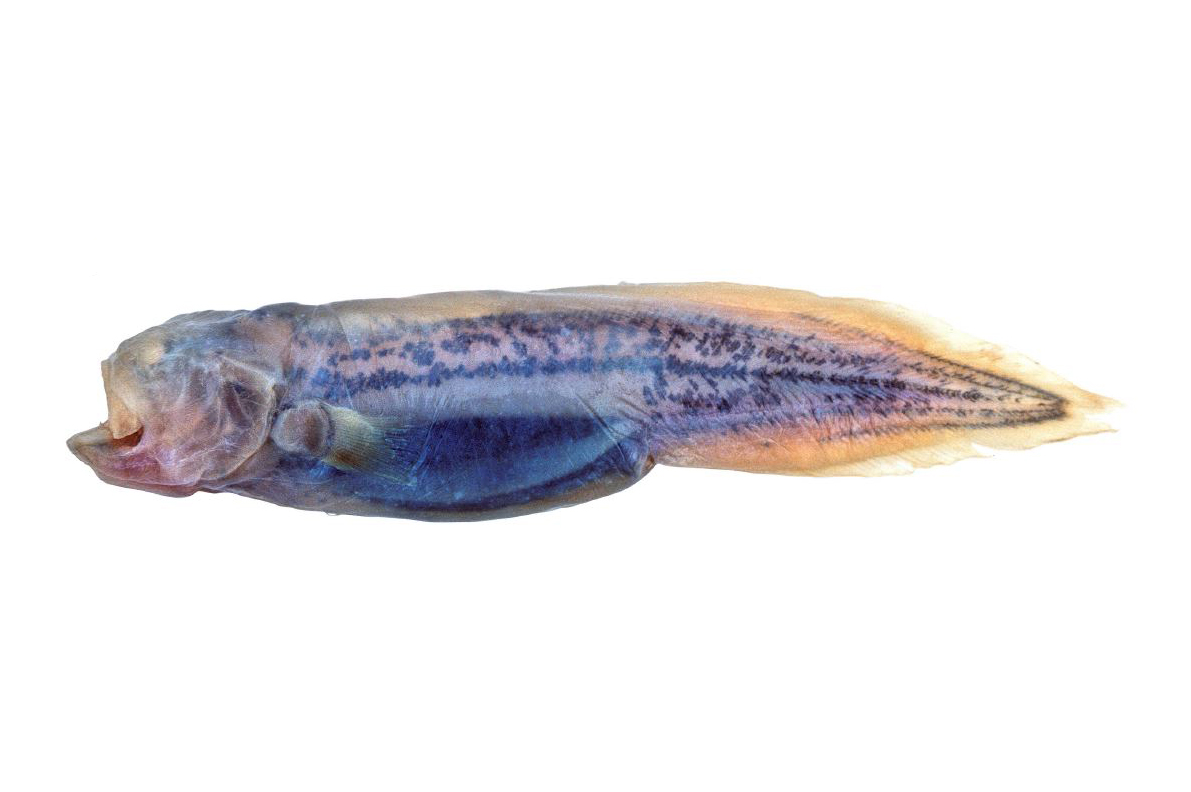Spotted Gelatinous Cusk, Barathronus maculatus Shcherbachev 1976

A Spotted Gelatinous Cusk, Barathronus maculatus, AMS I.24059-013, from off New South Wales. Source: Ken J. Graham / NSW Fisheries. License: CC By Attribution-NonCommercial-ShareAlike
Summary:
A reddish gelatinous cusk with loose, scaleless, semi-transparent skin, a dark peritoneum and an irregular dark pattern along the side. The eyes are only externally visible in specimens less than ~14 cm, appearing as a narrow, dark ring surrounding paler tissue.
Cite this page as:
Bray, D.J. 2022, Barathronus maculatus in Fishes of Australia, accessed 27 Jun 2025, https://fishesofaustralia.net.au/Home/species/4071
Spotted Gelatinous Cusk, Barathronus maculatus Shcherbachev 1976
More Info
|
Distribution |
East of Port Stephens to east of Nowra, New South Wales, and north of the Dampier Archipelago to southwest of Imperieuse Reef, Western Australia, in depths of 500-1150 m; also the Lord Howe Rise in the Tasman Sea. Elsewhere the species occurs in the Indo-west Pacific: South Africa to Japan and the Philippines. |
|
Features |
Dorsal fin 75-83; Anal fin 55-66;Vertebrae 74-79, caudal vertebrae 39-42. Vomer with up to 4 fangs and dentary with up to 5 fangs. Length of penis up to 10 % SL; it is proximally covered by a large dorsal clasper and a smaller ventral clasper protected ventrally by a well-developed fleshy hood. In specimens longer than about 140 mm SL the eyes are not externally visible while the eyes of smaller specimens appear as a narrow, dark ring surrounding lighter tissue. |
|
Size |
This is the largest known species in the genus Barathronus. |
|
Biology |
Viviparous - gives birth to live young. |
|
Fisheries |
Taken occasionally as bycatch in commercial trawl fisheries working on the upper continental slope. |
|
Similar Species |
Differs from all other Barathronus species in having distinct, dark blue pigmentation dorsally between the head and the dorsal fin, and on sides of the reddish body. Also the following combination of characters is diagnostic: dorsal fin rays 75–83, anal fin rays 55–66, vertebrae 74–79, vomer with up to four fangs and dentary with up to five fangs. Length of penis up to 10 % SL; it is proximally covered by a large dorsal clasper and a smaller ventral clasper protected ventrally by a well-developed fleshy hood. In specimens longer than about 140 mm SL the eyes are not externally visible while the eyes of smaller specimens appear as a narrow, dark ring surrounding lighter tissue |
|
Etymology |
The specific name if from the Latin maculatus (= spotted, marked with spots), in reference to the “distinctly visible” spots along mid-line of the body. |
|
Species Citation |
Barathronus maculatus Shcherbachev 1976, Voprosy Ikhtiologii 16(1): 162-165 1 fig. [in Russian; English translation J. Ichthyol. 16(1): 146–149] [164, fig. B]. Type locality: Off Maputo, Mozambique, western Indian Ocean, 26°41'S, 34°06'E, depth 1000 m. |
|
Author |
Bray, D.J. 2022 |
|
Resources |
Spotted Gelatinous Cusk, Barathronus maculatus Shcherbachev 1976
References
Cohen, D.M. & Nielsen, J.G. 1978. Guide to the identification of genera of the fish order Ophidiiformes with a tentative classification of the order. National Marine Fisheries Service (U.S.). Technical Report 417: 1-72 figs 1-103
Fennessy, S., Holleman, W., Russell, B. & Maunde, C. 2020. Barathronus maculatus. The IUCN Red List of Threatened Species 2020: e.T190236A141807188. https://dx.doi.org/10.2305/IUCN.UK.2020-1.RLTS.T190236A141807188.en. Accessed on 16 August 2022.
Nielsen, J.G. 1986. Family No. 99: Aphyonidae. pp. 356-357 in Smith, M.M. & Heemstra, P.C. (eds). Smith's Sea Fishes. Johannesburg : Macmillan South Africa xx + 1047 pp. 144 pls.
Nielsen, J.G., Cohen, D.M., Markle, D.F. & Robins, C.R. 1999. Ophidiiform Fishes of the World. An annotated and illustrated catalogue of pearlfishes, cusk-eels, brotulas and other ophidiiform species known to date. FAO Fisheries Synopsis No. 125 Vol. 18. 178 pp.
Nielsen, J.G. & Machida, Y. 1985. Notes on Barathronus maculatus (Aphyonidae) with two records from off Japan. Japanese Journal of Ichthyology 32(1): 1-5.
Nielsen, J.G., Pogonoski, J.J. & Appleyard, S.A. 2019. Aphyonid-clade species of Australia (Teleostei, Bythitidae) with four species new to Australian waters and a new species of Barathronus. Zootaxa 4564(2): 554–572, http://dx.doi.org/10.11646/zootaxa.4564.2.12.
Shcherbachev, Y.N. 1976. New species of the family Aphyonidae (Pisces, Ophidiodea) from the Indian Ocean. Voprosy Ikhtiologii 16(1): 162-165 1 fig. [in Russian; English translation in Journal of Ichthyology 16(1): 146–149]
Yeh, H.M., Lee, M.Y. & Shao, K.T. 2009. New Records of Two Aphyonid Fishes (Pisces: Aphyonidae), Aphyonus gelatinosus Günther, 1878 and Barathronus maculatus Shcherbachev, 1976, from the deep waters adjacent to Taiwan. Journal of Fisheries Society of Taiwan 36(3): 225-232.



